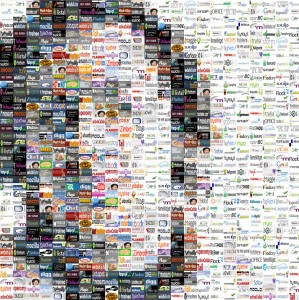Reading the articles for class this week and the discussions around 2.0 software and services got me thinking about the use of 2.0 as a suffix. While it’s used in the academy to represent anything that’s improved or facilitated by the use of social software (or, in the case of library services, denotes using such apparatuses to encourage participation in shaping library programs) and used in the industry to denote events that have been made possible via the use of this technology (see, for example, Lunch 2.0), it’s also often used out of context by a bevy of marketers in order to indicate anything that’s the next version of an older model. Even though 2.0 is now largely a signifier of inclusionary and connective practices that have been altered or are established through social software, I find it interesting that we use 2.0 (or 3.0, or 4.0) as a term to represent the changes that are taking place. Why not “the inclusionary web” or something else that indicates the changes that are occurring in a more easily identifiable / descriptive way? Why is our shorthand so often numeric?
I think that “2.0” and the numeric value system for improvements in technological apparatuses has been a trope for some time now, long before we started attaching it to things like “Web,” “Library,” “Love” or “Me”. I remember way back in the day when my parents got our family’s first computer, and it ran on DOS 3.1 or somesuch – the addition of digits were there to hallmark some incremental change in software, and when there was a major enough revision it would bump up to the next whole number. All it originally was was a way to delineate development in-house, in such a way that the user could easily identify an outdated product.

Album art for Garbage "2.0"
It was highly useful for this purpose, and then it got picked up by the media to denote any sort of change at all. One of my favorite early 90’s bands, Garbage, even named their second album 2.0.
The changes that are occurring with social software online are happening so fast and are so radical (in relation to the inclusionary paradigms that they promote) that I think we’re using the number system for it not only because we tend to enumerate everything, but also as a means of slowing it down so that it doesn’t seem so overwhelming and out of control. I also largely hear academics and theorists using the term 2.0 far more often than by anyone 20 or under in conversation, the youth who are actually designing many of the programs that are now changing the way we communicate, learn, earn a living and fall in love. Maybe it’s just me (and it definitely might be), but I see the grafting of labels as a means of containment, playing catch-up with the affordances we’re finding in our technologies and their effects on social movements.
I think it’s definitely arguable that the numeric value system has been employed out of tradition and is, in a way, a crutch. It’s a way of rationalizing and compartmentalizing progression in a way that can be easily understood. I think that there’s an innate desire for us to define things in numbers so that we can feel that we’re moving towards something bigger – thinking here of second edition books, second generation iPods, Playstation 2… 3. The number system allows us to interpret things as finished, placing historical caps on events or objects so that we can move onto the next logical step. We’re already seeing Web 3.0, where (from my understanding) the connectivity extends to nearly every piece of machinery that we have to create an even more interactive, humanistic web that’s based on openness – I’ve read lots of shifting definitions, however, and the only thing that seems to be certain that whatever Web 3.0 is going to represent, it will definitely be called Web 3.0.

The New You - Self 2.0
I think that it’s valuable to attach numeric values to some things, but it’s also very limiting in a way. We tend to disparage first generation things or ideas once the second or third has come out. When we start attaching 2.0 to things like Love or the Self, we run the risk of disqualifying 1.0 concepts as archaic, or worse, redundant as we automatically assume that the original concepts are already embedded in the 2.0, “improved” model. Personally, I’m a big fan of 1.0 when applied to some of the abstract concepts that 2.0 is being grafted onto, and I’m reticent to see them go. For example: The idea that relationships that are facilitated by online dating sites that base your compatibility on a series of inputted statistics for a likely positive outcome is great in some ways, but what I’m concerned with is that it may, because of the terminology (and the excitement behind the technology), become privileged over earlier forms of connecting with others… What about that chance meeting in a coffee shop with someone you find you have nothing in common with, but who compels you nonetheless?
Even applied to technology and software, 2.0 can be a dangerous term because I think we inherently see it as a cutting point, a means of identifying what’s done and over with through retrospect. How much potential do we lose from 1.0 models once the focus has shifted to 2.0? Granted, like the readings state, 2.0 indicates involvement, training and a sense of obligation to improve through contribution, but what if some of the foundations of the way we approach our ideas and online social movements are fundamentally flawed? Not saying they are, of course, but the number system seems to suggest that there are negative associations with questioning the foundations of our paradigms, and to do so would be of as little value as nostalgia.
Categories: